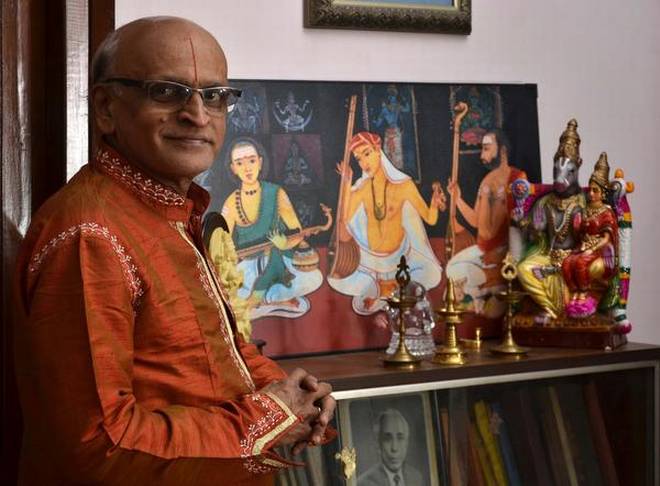Dr. Vageesh, musician-musicologist, traces his career with Akashvani
It was good to see Dr. K. Vageesh receive the Ganakala Bhushana Award at the 47th Karnataka Ganakala Parishath proceedings recently in Bengaluru. The 62-year-old musician-musicologist-composer committed to his task at the helm of Akashvani for 36 years came up with an informative lec-dem as he explained the nuances of the much-debated Abheri and Karnataka Devagandari.
“Only a musician, who is also a musicologist can demonstrate such finenuances,” said Dr. R.K. Padmanabha, president of the Ganakala Parishath after honouring Dr. Vageesh with the Ganakala Bhushana Award. “Vageesh, who is integral to the much-appreciated AIR auditions, has studied, sung, reflected and worked with the grammar of music for more than four decades. The Parishath is happy to recognise his lifetime achievements,” announced Mr. Padmanabha.
Dr. Krishna Vageesh, top-grade artist of AIR, now on an extension as the Deputy Director General (Music) Prasar Bharati, New Delhi, was born in 1954 in Mysore. Belonging to a family obsessed with classical melody for generations, he also boasts a lineage of love for Sanskrit, the Vedas and divinity attached to temple histories.
Music was deep-rooted with grandfather Srirangachar rubbing shoulders with M.D. Ramanathan as his classmate. Vageesh also took guidance from Tiger Varadachari. “M.D. Ramanathan visited us at Kathwadipura Agrahara in Mysore, a traditionally erudite neighbourhood where we were brought up. He once heard me sing the Kamalamba Navavarana kriti and had prophesied that I would make it big,” reminisces Vageesh.
Mysore has always been a vibrant cultural hub. “The echoes of naada and Veda in the Agrahara where I grew up still linger in my ears,” says Vageesh.
Three awards
Vageesh’s entry into Akashvani was just by chance. “I was a senior chemist with SKF and was frequently recording for Akashvani. Y.S.K. Rao, then Director, who listened to me on one such occasion, said, ‘Why don’t you apply for a job in Akashvani?’ Soon I was selected through UPSC as Programme Executive at New Delhi Akashvani in 1980. I was put in charge of Yuvavani,” recalls Dr. Vageesh. “I am grateful to stalwarts such as veena Doreswamy Iyengar and R.K. Srikantan, who encouraged me to be part of radio broadcasting. I bagged three annual awards for my musical productions, Navras, Silence in Music and Haathon Ka Tharaana,” he says.
Although his aunt H.S. Mahalakshmi of the Tiger Varadachari school was his formal guru, this gold medallist in M.A. (Music) expanded his horizon with guidance from faculty stalwarts such as Prof. Ramarathnam, Gowrie Kuppuswamy and R. Vishweshwaran. “They helped me reach where I am today,” says Vageesh. “I used to observe all the old-time greats too and that included their mannerisms. I loved imitating them and even adopted some of their techniques in my presentations,” he says. This analytical mind helped me pursue a doctorate in Dikshitar compositions.”
Vageesh was a winner all along, from music competitions in school and college, to State and reputed music organisations such as the Bangalore Gayana Samaja, Karnataka Ganakala Parishath and the Music Academy in Chennai. Winning the AIR competition earned him a B-grade status as a youth artist.
Vageesh considers his stint as the Assistant Station Director in charge of the music section at the Directorate a precious opportunity as he watched stalwarts such as M.S. Gopalakrishnan, Emani Sankara Sastry, Madirimangalam Ramachandran and T.K. Govinda Rao conduct their orchestral productions. The years as the Deputy Director, National Programmes and Sangeeth Sammelan later, was a huge learning curve as he discussed the orchestrated pieces with sitar maestro Ravishankar, Vijaya Raghava Rao and Anil Biswas.
Vageesh’s phase as a composer began 15 years ago, with a kriti in raga Ranjani. He has to his credit 100 compositions as varnams, kritis and tillanas. “I have a few CDs of my compositions too,” says Vageesh, who conducts Tyagaraja aradhana at his residence in Bengaluru every year.
source: http://www.thehindu.com / The Hindu / Home> Society> History & Culture / Ranjani Govind / February 23rd, 2017






